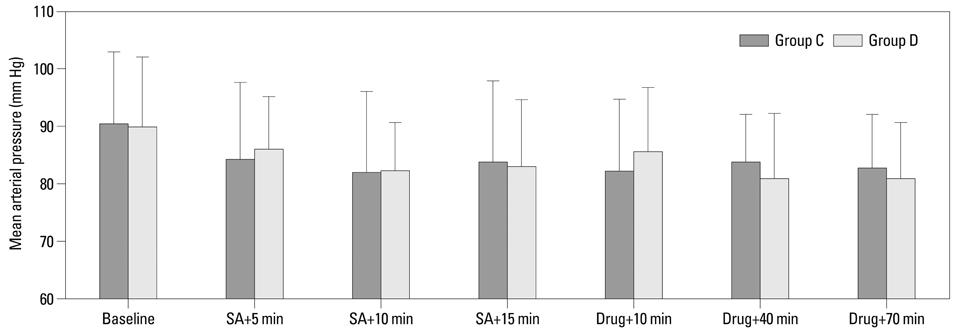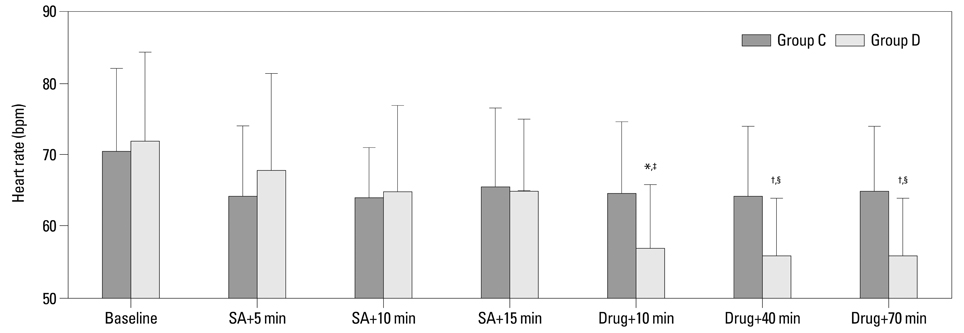Yonsei Med J.
2014 Mar;55(2):517-522.
Effect of Dexmedetomidine on the Corrected QT and Tp-e Intervals during Spinal Anesthesia
- Affiliations
-
- 1Department of Anesthesiology and Pain Medicine and the Anesthesia and Pain Research Institute, Yonsei University College of Medicine, Seoul, Korea. hanesth@yuhs.ac
Abstract
- PURPOSE
The aim of this study is to evaluate the effect of dexmedetomidine on corrected QT (QTc) and Tp-e intervals in patients undergoing spinal anesthesia.
MATERIALS AND METHODS
We studied 50 patients who were scheduled to undergo spinal anesthesia before orthopedic surgeries. Patients were allocated to receive either an infusion of dexmedetomidine or normal saline after spinal anesthesia.
RESULTS
QTc intervals were significantly prolonged after spinal anesthesia, and the prolonged QTc interval returned to baseline values 10 minutes after either normal saline or dexmedetomidine administration in both groups. The QTc interval values after dexmedetomidine administration were significantly shorter compared to the QTc interval values just before dexmedetomidine administration.
CONCLUSION
Dexmedetomidine could promote the return of a prolonged QTc interval induced by spinal anesthesia and might be helpful in patients who have a prolonged QTc interval.
MeSH Terms
Figure
Reference
-
1. Bhana N, Goa KL, McClellan KJ. Dexmedetomidine. Drugs. 2000; 59:263–268.
Article2. Hayashi Y, Sumikawa K, Maze M, Yamatodani A, Kamibayashi T, Kuro M, et al. Dexmedetomidine prevents epinephrine-induced arrhythmias through stimulation of central alpha 2 adrenoceptors in halothane-anesthetized dogs. Anesthesiology. 1991; 75:113–117.
Article3. Tsutsui K, Hayami N, Kunishima T, Sugiura A, Mikamo T, Kanamori K, et al. Dexmedetomidine and clonidine inhibit ventricular tachyarrhythmias in a rabbit model of acquired long QT syndrome. Circ J. 2012; 76:2343–2347.
Article4. Hammer GB, Drover DR, Cao H, Jackson E, Williams GD, Ramamoorthy C, et al. The effects of dexmedetomidine on cardiac electrophysiology in children. Anesth Analg. 2008; 106:79–83.
Article5. Wisely NA, Shipton EA. Long QT syndrome and anaesthesia. Eur J Anaesthesiol. 2002; 19:853–859.
Article6. Booker PD, Whyte SD, Ladusans EJ. Long QT syndrome and anaesthesia. Br J Anaesth. 2003; 90:349–366.
Article7. Nacif-Coelho C, Correa-Sales C, Chang LL, Maze M. Perturbation of ion channel conductance alters the hypnotic response to the alpha 2-adrenergic agonist dexmedetomidine in the locus coeruleus of the rat. Anesthesiology. 1994; 81:1527–1534.
Article8. Sculptoreanu A, Scheuer T, Catterall WA. Voltage-dependent potentiation of L-type Ca2+ channels due to phosphorylation by cAMP-dependent protein kinase. Nature. 1993; 364:240–243.
Article9. Moss AJ. Measurement of the QT interval and the risk associated with QTc interval prolongation: a review. Am J Cardiol. 1993; 72:23B–25B.
Article10. Fridericia LS. The duration of systole in an electrocardiogram in normal humans and in patients with heart disease. 1920. Ann Noninvasive Electrocardiol. 2003; 8:343–351.
Article11. Owczuk R, Sawicka W, Wujtewicz MA, Kawecka A, Lasek J, Wujtewicz M. Influence of spinal anesthesia on corrected QT interval. Reg Anesth Pain Med. 2005; 30:548–552.
Article12. Stewart J, Kellett N, Castro D. The central nervous system and cardiovascular effects of levobupivacaine and ropivacaine in healthy volunteers. Anesth Analg. 2003; 97:412–416.
Article13. Knudsen K, Beckman Suurküla M, Blomberg S, Sjövall J, Edvardsson N. Central nervous and cardiovascular effects of i.v infusions of ropivacaine, bupivacaine and placebo in volunteers. Br J Anaesth. 1997; 78:507–514.
Article14. Hung O. Understanding hemodynamic responses to tracheal intubation. Can J Anaesth. 2001; 48:723–726.
Article15. Haapalahti P, Viitasalo M, Perhonen M, Mäkijärvi M, Väänänen H, Oikarinen L, et al. Electrocardiographic interventricular dispersion of repolarization during autonomic adaptation in LQT1 subtype of long QT syndrome. Scand Cardiovasc J. 2008; 42:130–136.
Article16. Lindgren L, Rautiainen P, Klemola UM, Saarnivaara L. Haemodynamic responses and prolongation of QT interval of ECG after suxamethonium-facilitated intubation during anaesthetic induction in children: a dose-related attenuation by alfentanil. Acta Anaesthesiol Scand. 1991; 35:355–358.
Article17. Kweon TD, Nam SB, Chang CH, Kim MS, Lee JS, Shin CS, et al. The effect of bolus administration of remifentanil on QTc interval during induction of sevoflurane anaesthesia. Anaesthesia. 2008; 63:347–351.
Article18. Veering BT, Cousins MJ. Cardiovascular and pulmonary effects of epidural anaesthesia. Anaesth Intensive Care. 2000; 28:620–635.
Article19. Baron JF, Payen D, Coriat P, Edouard A, Viars P. Forearm vascular tone and reactivity during lumbar epidural anesthesia. Anesth Analg. 1988; 67:1065–1070.
Article20. Antzelevitch C. Arrhythmogenic mechanisms of QT prolonging drugs: is QT prolongation really the problem? J Electrocardiol. 2004; 37:Suppl. 15–24.
Article21. Saarnivaara L, Hiller A, Oikkonen M. QT interval, heart rate and arterial pressures using propofol, thiopentone or methohexitone for induction of anaesthesia in children. Acta Anaesthesiol Scand. 1993; 37:419–423.
Article22. Han DW, Park K, Jang SB, Kern SE. Modeling the effect of sevoflurane on corrected QT prolongation: a pharmacodynamic analysis. Anesthesiology. 2010; 113:806–811.23. Tan JA, Ho KM. Use of dexmedetomidine as a sedative and analgesic agent in critically ill adult patients: a meta-analysis. Intensive Care Med. 2010; 36:926–939.
Article24. Shimizu S, Akiyama T, Kawada T, Sata Y, Mizuno M, Kamiya A, et al. Medetomidine, an α(2)-adrenergic agonist, activates cardiac vagal nerve through modulation of baroreflex control. Circ J. 2012; 76:152–159.
Article25. Parent BA, Munoz R, Shiderly D, Chrysostomou C. Use of dexmedetomidine in sustained ventricular tachycardia. Anaesth Intensive Care. 2010; 38:781.26. Stengl M, Volders PG, Thomsen MB, Spätjens RL, Sipido KR, Vos MA. Accumulation of slowly activating delayed rectifier potassium current (IKs) in canine ventricular myocytes. J Physiol. 2003; 551(Pt 3):777–786.
Article
- Full Text Links
- Actions
-
Cited
- CITED
-
- Close
- Share
- Similar articles
-
- Prolonged Tp-e Interval, Tp-e/QT Ratio and Tp-e/QTc Ratio in Patients with Type 2 Diabetes Mellitus
- The correlation of heart rate between natural sleep and dexmedetomidine sedation
- Laparoscopic appendectomy under spinal anesthesia with dexmedetomidine infusion
- Fatal pulmonary aspiration during balanced sedation with dexmedetomidine and midazolam: A case report
- Optimal dose of dexmedetomidine for sedation during spinal anesthesia



